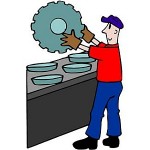
Briefly about QC
Quality Control (QC) is a consistent process that ensures the obtained result within a project is aligned with the product scope. During this process the project manager and the QC team review the product against acceptance criteria to ensure all the features and functions that characterize the product are completely embodied in it and work properly.
When the quality control process is correctly applied, the overall effectiveness of the project team is improved, and the project tends to be successful. In case the process is weak or inadequate, there is a high likelihood that a project scope or product requirement creep will arise.
QC is a component (sometimes considered “sub-process“) of the quality management process. Along with quality assurance (QA) and quality planning (QP), it aims to prevent situations where a project product has been delivered unaligned with the acceptance criteria. QP, QA and QC build the mechanism of confirming that the product is complete and acceptable.
QC is the final step within the quality management process. It is carried out at every stage of the project implementation lifecycle to reach compliance with product requirements. QC best practices assume that the process itself should be reviewed at a stage’s beginning in order to ensure it is correct and adequate.
QC Best Practices
A person or team responsible for quality management needs to ensure that the related project activities can be regarded as accomplished and the entire project can move further. Below is a sample agenda of that person (team) that states the following 4 QC best practices:
- Develop a schedule
- Hold a meeting
- Assign roles
- Follow-up the Review
Develop a Quality Review Schedule
The very first step the QA engineers need to take is to have a clear idea of the activities related to a given project stage in order to understand their purpose, duration and sequence. It is necessary for creating a schedule that specifies exact time when every activity will be checked against quality requirements.
Such a schedule determines quality reviews that need to take place. This document should be adjusted to either individual calendars or separate milestones. It is a best practice to schedule quality reviews at the beginning of a stage and then repeat those reviews on a regular basis (e.g. each two weeks or monthly) until the stage finishes.
This practice lets ensure that the reviewers know in advance when to start taking an action. It also helps prevent conflicts with individual calendars. Moreover, the project team will be able to create intermediate products complied with quality requirements, and therefore the overall performance will be improved.
Hold a Meeting
Once the schedule for quality reviews is developed the next step is to create an agenda that will tell the reviewers what objective, roles and responsibilities to perform and what products to examine and audit.
The agenda should be distributed between the QC team before the reviews are actually started (usually not less than 1 week prior the first review). The team should read and understand the agenda, and the team leader should conduct a quality review meeting to discuss the document and ensure everybody knows how to act. The QC schedule should also be discussed on such a meeting.
Along with the agenda, there should be developed and agreed specific QC standards (based on product acceptance criteria) which define the structure, format and content of the product to be audited. The QC team will then evaluate the product against those standards to ensure product accuracy and completeness.
Assign Roles
It is a QC best practice to conduct a quality review in a structured and formal manner. And participants of that review need to carry out a range of roles that determine their behaviors and responsibilities.
The following roles are typical:
- Facilitator. A person assigned to this role takes responsibility for scheduling the review, ensuring successful implementation according to the QC schedule, and communicating with the project manager regarding the results obtained.
- Author. It is about presenting the product to the QC team, providing necessary information, and applying recommended corrections after the quality review finishes.
- Analyst. This role assumes that the reviewer must identify any deficiency in the product and write a summary of the analysis, which is later used in decision making.
- Secretary. A person who documents the QC process and makes and keeps records on identified deficiencies in the product.
There can be other best practice roles, for example Expert, Stage Manager, Owner, Engineer, others. The number and type of QC roles will depend on the nature and complexity of project product to be audited and analyzed.
Follow Up the Review
Quality control continues until all recommendations and suggestions developed during quality reviews are applied to the product. After the reviews are finished, the facilitator needs to communicate with the project manager to discuss and agree on a follow-up plan.
The author will apply corrections according to the plan. The analyst will then review the corrected version of the product to ensure that it fits into the standards and that there is no need for further analysis and correction. The secretary will record all steps of the QC process and document all the updates made to the product.
After that, the facilitator will confirm that the product is reviewed against the standards and so it is corrected according to acceptance criteria. Then the project manager (or the stage manager) will get involved in further decision making regarding product acceptance and handover.